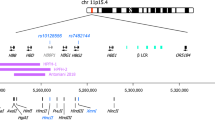Summary
Twenty-two patients with mild haemolytic anaemia and haemoglobin (Hb) Constant Spring (CS) of around 6% were studied because they were suspected of having homozygous Hb CS. Family studies revealed Hb CS trait in both parents of eight patients, supporting that they were homozygous for Hb CS. The other patients were included because they had clinical and haematological features similar to the diagnosed cases of homozygous Hb CS. Heterozygosity and homozygosity for Hb CS are clearly distinguishable in that the former is asymptomatic but the latter is associated with overt haemolytic anaemia, and the levels of Hb CS in the two conditions of less than 1% and around 6%, respectively, do not overlap. The findings in homozygous Hb CS contracdict prediction. There are four a-structural genes per normal human diploid genome. Hb CS trait is believed to be almost equivalent to a-thalassaemia 2 or a loss of one a-gene because HB CS, an a-variant, is barely or not detectable. Homozygosity for Hb CS has thus been predicted to be equivalent to a-thalassaemia 1 or a loss of two genes. The latter is asymptomatic and associated with microcytic-hypochromic red cells. However, Hb CS homozygosity presents with mild overt haemolytic anaemia and normal sized red cells. Pathogenesis associated with Hb CS inheritance is more complex than originally believed. There is a possibility that the unstable a CS mRNAs precipitate and aggregate leading to pathology of red cells and to the basophilic stippling appearance, so striking in this syndrome.
Similar content being viewed by others
References
Boyer SH, Fainer DC, Naughton HA (1963) Myoglobin; inherited structural variation in man. Science 140:1228–1231
Clegg JB, Naughton MA, Weatherall DJ (1965) An improved method for the characterization of human haemoglobin mutants: Identification of α2 β 2 95Glu, haemoglobin N (Baltimore). Nature 207:945–947
Clegg JB, Weatherall DJ, Milner PF (1971) Haemoglobin Constant Spring-a chain termination mutant? Nature 234:337–340
Clegg JB, Weatherall DJ (1974) Hemoglobin Constant Spring, an unusual a-chain variant involved in the etiology of hemoglobin H disease. Ann NY Acad Sci 232:168–177
Cook JD (1970) An evaluation of absorption methods for measurement of plasma iron-binding capacity. J Lab Clin Med 76:497–506
Dacie JV, Lewis SM (1975) Practical haematology, 5th edn. Churchill Livingstone, Edinburgh London New York
Danon D (1963) A rapid micromethod for recording red cell osmotic fragility by continuous decrease of salt concentration. J Clin Pathol 16:377–382
International committee for standardization in hematology (1971a) Recommended methods for radioisotope red cell survival studies. Blood 38:378–386
International committee for standardization in haematology, expert panel on iron (1971b) Proposed recommendation for measurement of serum iron in human blood. Br J Haematol 20:451–453
Kan YW, Todd D, Dozy AM (1974) Haemoglobin Constant Spring synthesis in red cell precursors. Br J Haematol 28:103–107
Kan YW, Dozy AM, Varmus HE (1975) Deletion of a-globin genes in Haemoglobin-H disease demonstrates multiple a-globin structural loci. Nature 255:255–256
Lie-Injo LE, Ganesan J, Clegg JB, Weatherall DJ (1974) Homozygous states for Hb Constant Spring (slow-moving x components). Blood 43:251–259
Milner PF, Clegg JB, Weatherall DJ (1971) Haemoglobin H disease due to a unique haemoglobin variant with an elongated a-chain. Lancet 1:729–732
Ottolenghi S, Lanyon WG, Paul J, Williamson R, Weatherall DJ, Clegg JB, Pritchard J, Pootrakul S, Boon WG (1974) Gene deletion as the cause of a-thalassemia. Nature 251:389–392
Pongsamart S, Pootrakul S, Wasi P, Na-Nakorn S (1975) Hemoglobin Constant Spring: hemoglobin synthesis in heterozygous and homozygous states. Biochem Biophys Res Commun 64:681–685
Pootrakul S, Kemathorn B, Pravatmuang P, Pongsamart S, Na-Nakorn S (1976a) Hemoglobin Constant Spring: degradation and synthesis studies. Excerpta Med Int Cong Ser (Proc 16th Int Congr Hematology) 415:310–314
Pootrakul S, Assawamunkong S, Na-Nakorn S (1976b) Hemoglobin synthesis in β-thalassemia traits and Hb E trait. Abstracts free communications and scientific exhibition, 16th Int Congr Hematology, Kyoto, Japan, Sept 5–11, p 51
Pootrakul S, Assawamunkong S, Na-Nakorn S (1976, 1977) 255-2 trait: hematologic and hemoglobin synthesis studies. Hemoglobin 1:75–83
Ramirez F, Natta C, O'Donnell JV, Canafe V, Bailey G, Sanguansermsri T, Maniatis GM, Marks PA, Bank A (1975) Relative numbers of human globin genes assayed with purified a and β complementary human DNA. Proc Natl Acad Sci USA 72:1550–1554
Singer K, Chernoff AI, Singer L (1951) Studies on abnormal hemoglobins. I. Their demonstration in sickle cell anemia and other hematologic disorders by means of alkali denaturation. Blood 6: 413–428
Smithies O (1959) An improved procedure for starch-gel electrophoresis: further variations in the serum proteins of normal individual. Biochem J 71:585–587
Taylor JM, Dozy A, Kan YW, Varmus HE, Lie-Injo LE, Ganesan J, Todd D (1974) Genetic lesion in homozygous a-thalassemia (hydrops foetalis). Nature 251:392–393
Wasi P, Disthasongchan P, Na-Nakorn S (1968) The effect of iron deficiency on the levels of hemoglobin A2 and E. J Lab Clin Med 71:85–91
Wasi P, Na-Nakorn S, Pootrakul S (1974) The a-thalassemias. Clin Haematol 3:383–410
Wasi P, Pootrakul S, Pootrakul P, Pravatmuang P, Winichagoon P, Fucharoen S (1980) Thalassemia in Thailand. Ann NY Acad Sci 344:352–363
Weatherall DJ, Clegg JB (1975) The a-chain-termination mutants and their relation to the a-thalassemias. Philos Trans R Soc Lond [Biol] 271:411–455
Author information
Authors and Affiliations
Rights and permissions
About this article
Cite this article
Pootrakul, P., Winichagoon, P., Fucharoen, S. et al. Homozygous haemoglobin constant spring: A need for revision of concept. Hum Genet 59, 250–255 (1981). https://doi.org/10.1007/BF00283674
Received:
Issue Date:
DOI: https://doi.org/10.1007/BF00283674




